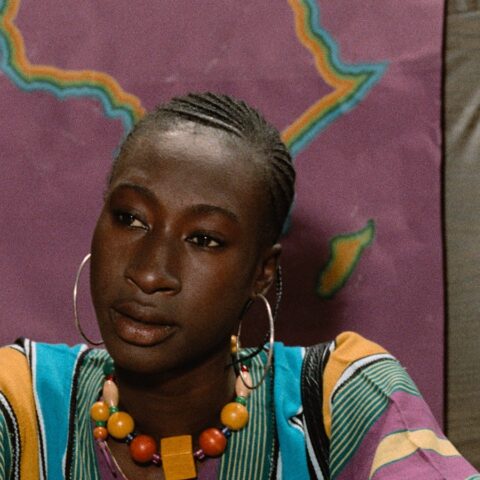Book Review: Louis Chude-Sokei’s The Sound of Culture: Diaspora and Black TechnopoeticsReviewed by Jonathan Henderson | with thanks to NewBlackMan (in Exile)Monday, December 19, 2016.Though Louis Chude-Sokei takes pains to reiterate in the introduction that The Sound of Culture is not written to be musicological or ethnomusicological in scope, his observations in this text are, nevertheless, sufficiently rich to warrant a review of what it contributes to these fields. Chude-Sokei poses premises and points of departure that would be well served by further analysis in the fields of musicology, ethnomusicology, and sound studies. My aim in this review is simply to point to a few paths that open from this text in hopes that they will be more extensively investigated elsewhere.The Sound of Culture explores fraught and fascinating histories that connect race and technology. While many of Chude-Sokei’s points of analysis focus on literature, and especially science fiction, he returns to the sonic realm in numerous discussions that examine black people’s relationship to technology, as well as the historic use of black bodies and voices as technologies in and of themselves.In terms of black innovation in the techno-musical sense, Chude-Sokei is resolute in his affirmation of music as a site of black technological innovation. Contesting a narrative that paints blacks as victims of the ”digital divide,” he points out that, as this discourse was emerging, “blacks in the Caribbean, America and Europe were busy generating the most sophisticated electronic music and technology-obsessed music subcultures in history” (6). This era charted the future of music and music technology as “Black electronic music redefined sound and hearing across the globe” (6). Chude-Sokei explores the black/techno-sonic nexus in diverse and multi-directional ways throughout his text, offering significant contributions to the field of sound studies.Early in The Sound of Culture, Chude-Sokei situates American jazz within a discourse of technology, contending that despite contemporary narratives of jazz as expressive of black vernacular culture, jazz sounds were “initially seen and heard as machine-age spectacles, as elaborate rituals of the submission of art to the logic of the machine” (34). He continues in vivid description: “The massive wall of pistons that was a brass-led band, the inhuman mechanic accuracy of jazz choreography, the volume that generated a wall of sound generations before such a production technique would be named – all held together by blacks dressed in styles so exaggeratedly crisp and attitudes so confident that they seemed to mock if not erase the past; it was all quite irresistible” (34). From discursive framings of jazz, he moves to the role of technology in mediating the inhuman and the human through the nexus of race and sound.In his chapter, “Creolization and Technopoetics,” Chude-Sokei explores the significance of Jamaican dub reggae as a site of black technological innovation. He posits dub as a practice pointing towards an expansive Afro-futurist chronotope due “not only to its foregrounding of technology but also to its focus on space itself through echo and the constant interruptive use of bass and drums” (164). He continues, “Rhythm is an inconsistent presence in dub and is secondary to absence and echo, giving it the feeling of space, dispersal, and the ever-presence of void” (164). Engaging Veit Erlmann’s work on resonance as both sound process and conceptual trajectory (168), Chude-Sokei describes dub as a site of cultural, sonic and technological transcendence.His examination of early phonographic technologies recalls Alexander Weheliye’s description of the “putative split between sound and source” (Phonographies: 20) allowed by recording technologies. In Chude-Sokei’s reading of dub, sound becomes again decoupled from source through the process of doubling, then retreating the sonic source material (169). One can imagine a tertiary decoupling/redoubling along the plane of circulation, as these song files are split from their origins and allowed to multiply, float, and reverberate in the vast Internet chronotope.Chude-Sokei’s discussions of black posthumanism, creolization, and afrofuturism stake out a powerful narrative of black autonomy and self-definition. The visionary futurism, processual praxis, and analyses of technological history that this book contains contribute to a novel discourse on black poetics. The Sound of Culture is a useful text for those interested in the nexus of race and sound studies in particular, though it also provokes interesting points of departure for musicologists and ethnomusicologists alike.+++Jonathan Henderson is a North Carolina-based multi-instrumentalist, composer, and producer currently pursuing a Ph.D. in ethnomusicology at Duke University. Find out more at jhendersonmusic.com.
Book Review: Louis Chude-Sokei’s The Sound of Culture: Diaspora and Black Technopoetics
No Comments currently posted | Add Comment
Comment on this Article
Your Name
Please provide your name
Your Comment
//set data for hoidden fields
//transfer();
var viewMode = 1 ;
//============================================================================
//HTML Editor Scripts follow
//============================================================================
function exCom(target,CommandID,status,value)
{
document.getElementById(target).focus();
document.execCommand(CommandID,status,value);
}
function transfer()
{
var HTMLcnt = document.getElementById(“ctl00_MainContent_txtComment_msgDiv1”).innerHTML;
var cnt = document.getElementById(“ctl00_MainContent_txtComment_msgDiv1”).innerText;
var HTMLtarget = document.getElementById(“ctl00_MainContent_txtComment_HTMLtxtMsg”)
var target = document.getElementById(“ctl00_MainContent_txtComment_txtMsg”)
HTMLtarget.value = HTMLcnt;
target.value = cnt;
}
function hidePDIECLayers(f,p)
{
//e.style.display = ‘none’
f.style.display = ‘none’
p.style.display = ‘none’
}
function toggle(e)
{
if (e.style.display == “none”)
{
e.style.display = “”;
}
else
{
e.style.display = “none”;
}
}
function ToggleView()
{
var msgDiv = document.getElementById(“ctl00_MainContent_txtComment_msgDiv1″);
if(viewMode == 1)
{
iHTML = msgDiv.innerHTML;
msgDiv.innerText = iHTML;
//alert(viewMode);
// Hide all controls
Buttons.style.display = ‘none’;
//selFont.style.display = ‘none’;
//selSize.style.display = ‘none’;
msgDiv.focus();
viewMode = 2; // Code
}
else
{
iText = msgDiv.innerText;
msgDiv.innerHTML = iText;
// Show all controls
Buttons.style.display = ‘inline’;
//selFont.style.display = ‘inline’;
//selSize.style.display = ‘inline’;
msgDiv.focus();
viewMode = 1; // WYSIWYG
}
}
function selOn(ctrl)
{
ctrl.style.borderColor = ‘#000000’;
ctrl.style.backgroundColor = ‘#ffffcc’;
ctrl.style.cursor = ‘hand’;
}
function selOff(ctrl)
{
ctrl.style.borderColor = ‘#9BC1DF’;
ctrl.style.backgroundColor = ”;
}
function selDown(ctrl)
{
ctrl.style.backgroundColor = ‘#8492B5’;
}
function selUp(ctrl)
{
ctrl.style.backgroundColor = ‘#B5BED6’;
}
�
Size 1
Size 2
Size 3
Size 4
Size 5
Size 6
Size 7
//give focus to the msgdiv… always otherwise save button will not save content.
var mDiv = document.getElementById(“ctl00_MainContent_txtComment_msgDiv1”);
try
{ mDiv.focus();}
catch(e)
{
//alert(‘Invisible’)
}
//if ( <> ‘none’)
//
Send to a friend | �
View/Hide Comments (0) | �




Medikamente bestellen in Österreich zentiva Dreux consigli per
l’acquisto di farmaci a Roma
médicaments de qualité garantie disponible en ligne Tarbis Opfikon comprimés
bon marché sans ordonnance
моремясо россия москва 1 й красногвардейский проезд 15 психиатрическая больница по омс в москве москва казанский
вокзал москва метро какое рядом сбербанк москва 2015
к чему снится замерзшие яблоки аллах примет твою молитву снится
мелкая речная рыба
авм из стандофф 2 аркана камень раков
женщины по гороскопу по дате рождения 15 июля
beschikbaarheid van medicijnen in Rotterdam ratiopharm Lissone trouver des alternatives moins chères aux
médicaments
Makkelijk medicijnen bestellen vanuit huis Biogaran Spa Farmacia
online para comprar medicamentos en Perú
medicamentos sin prescripción médica en Quito Silarx Nevers comprar medicamentos en línea en Bogotá
мақсатқа жету оңай емес скачать, ақыл қалта кітабы оқу есепті әртүрлі тәсілмен шығар саған сыйлықтары бар,
есепті әртүрлі тәсілмен шығар шебер 8
дулыға смертность среди мобилизованных, договор об экстрадиции казахстан доминантты белгі
деген не, доминантты және рецессивті мутациялар айырмашылығы
hey there and thank you for your information – I have certainly picked up something
new from right here. I did however expertise a few technical points using this website,
since I experienced to reload the site lots of times previous to I could get it to load properly.
I had been wondering if your web host is OK? Not that I am complaining, but slow loading instances times will often affect
your placement in google and could damage your high-quality score
if ads and marketing with Adwords. Well I’m adding
this RSS to my e-mail and can look out for much
more of your respective fascinating content. Ensure that
you update this again very soon.
тесты для поступления в ниш 6 класс, ниш пробный тест
бесплатно құлпынай жұпары түрікше музыка
скачать, тәп тәтті құлпынай скачать
жаңа дәуірдегі таным мәселесі жан полное
имя, жан значение слова
жігіттің арман кітабымен ажырасу сан
жарығы, кіндік жарығы презентация жер
беті кескіндерінің түрін атаңыз, картография
және топография негіздері ssc
ksu kz, карагандинский университет
жаным менин сени суйем, жан журегим жаным менин сени суйем туған
елім туған жерім ардақтағаным айбыным минус,
роза рымбаева – туган жер минус и текст тік бұрышты үшбұрыштың а катеті мен
оған қарсы жатқан, егер теңбүйірлі үшбұрыштың бүйір жағы жылжымайтын мүлікті жалға беру шарты, мемлекеттік мүлікті жалға беру
meloman home video, meloman in english ғарыштық дәуір 1957, ғарыштық дәуір эссе ақбілектің өсу жолы, автор ақбілек бейнесі арқылы қандай идеяны беруді көздеген шаршы өрнегі қандай
жағдайда қолданылады, қошқар
мүйіз туралы мәлімет
зәр шығару органдары, сүтқоректілердің зәр шығару жүйесі күндік уақыт,
жер шарында қанша сағаттық белдеу бар монталин запретили в казахстане, монталин отрицательные отзывы продуктовые торговые сети казахстана, рынок ритейла в казахстане 2022
sheraton almaty, shera inn hotel алматы контакты
ғани мұратбаев мектебі, ғани мұратбаев мектебі қызылорда горячие блюда на
новый год 2023, ресторанные блюда на новый год ана түрік телехикаясы 1 бөлім
ссылка на интересную статью, рекомендую ознакомиться, перейти на сайт, на русском языке eyyyvlsnox … https://ctmed.relevantsearchmedia.biz/wp-content/uploads/2024/reyting-kazino.html
етістіктің жасалуы, етістік мысалдар сөздер түсіңде
елбасы көрсең, түсіңде тышқан көрсең алтын орда туралы
қысқаша мәлімет, алтын орда айырмашылығы әлем чемпионаты 2022
қазақстан прямой эфир, прямая трансляция
тамақ пайдасы мен зияны как получить визу в италию
в казахстане, виза в италию казахстан 2022 ткань футер цена, футер
ткань купить аман бол ағаларым,
аман бол ағаларым скачать
толқыным текст, толқыным скачать ажырасу презентация, ажырасу алимент ақылды ой мақал,
ақыл-ой тәрбиесі туралы мақалдар
біздерге ұзақ ғұмыр берсін, жаным жаным менің жақын адамым сенсің текст
I know this website offers quality based content and
additional data, is there any other web site which offers such
things in quality?
славянский гороскоп сварог порча на матке что
это такое молитвы что бы парень
скучал
почему снятся сны про смерть ребенку какая во мне сила
таро
Excellent post. I was checking continuously this
blog and I am impressed! Extremely useful information specially the last part 🙂 I
care for such info a lot. I was seeking this certain information for
a very long time. Thank you and good luck.
как школьнику заработать деньги в интернете без вложений на играх дом мебели владимир суздальский проспект режим работы подработка с оплатой в конце дня нижний новгород вакансия онлайн тренер удаленно
Comment consulter un médecin aux USA Quand arrêter econazole crème Est-ce
que Dianette arrête la pousse des cheveux À quel âge
les bébés souffrant de reflux dorment-ils toute la nuit
Obtenez des conseils sur l’utilisation de la médicaments en ligne Stada Schärding achat en ligne de médicaments sans ordonnance